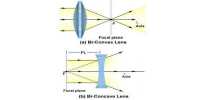Aqueous humour and Vitreous humour: The saline watery fluid that fills up the space between the eye lens and cornea is called aqueous humour. On the other hand, the jelly like substance that fills the gap between retina and eye lens is called vitreous humour.
Accommodation of eye: If an object is placed before a convex lens, it forms a real image at the back of the lens. If a. screen is placed at the back of the lens an inverted image of the object is found on the screen.
Experiment proves that in a certain place of the screen the image is most clear. For any reason, if the object is moved forward to or backward from the lens, the screen is to be moved forward or backward as well to get a clear image. Now if we want to get a clear image of the object on the screen at its previous position, we have to use lenses of different focal lengths.
Things happen in a similar way in case of eyes. The cornea, aqueous humour, eye lens and vitreous humour together work as a convergent lens system. If any object is placed before our eyes and if the image of that object is reflected on our retina, then there will be a sensation of vision in the brain. As a result, we see the object. We see objects of different distances through our eyes. The specialty of the eye lens is that it changes its shape according to the necessity and this it changes its focal length.
Due to the change of the focal length, image of objects at any position is always formed at the same distance from the lens. Therefore, clear images are formed on the retina. The capacity of eyes to change their focal length to see objects of any distance is called the accommodation power of eyes. And the process is called accommodation of eye.












